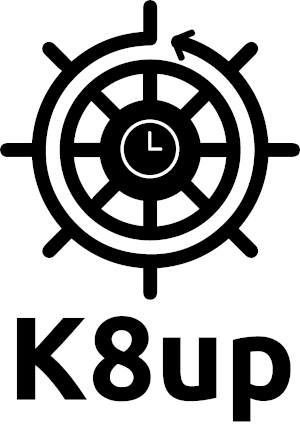Introduction
As Kubernetes solidifies its position as the orchestrator of choice for containerized applications, the need for robust backup solutions becomes paramount. Enter K8up – a Kubernetes Operator designed to handle PVC and application backups effortlessly. In this comprehensive guide, we’ll delve into K8up’s architecture, guide you through the installation process, and demonstrate its power through code snippets for general backups, application-aware backups, and the innovative pre-backup pods feature. Additionally, we’ll explore the restoration process, showcasing how K8up simplifies the recovery of your crucial data. Let’s embark on this journey of mastering Kubernetes backup strategies with K8up.
Architecture Demystified
At the heart of K8up’s prowess is its architecture, comprising two integral components:
-
K8up Operator: Deployed as a cluster-wide Kubernetes Operator, it processes Backup and Schedule resources. The Operator creates backup jobs based on defined schedules, scanning the namespace for matching PVCs and executing Restic to back up data to the configured endpoint.
-
Restic Wrapper (k8up Restic): The Restic wrapper is responsible for executing backup commands in Pods. When a backup is triggered, the Operator creates a corresponding Job, and the Restic wrapper (via a container) performs the actual backup using the Restic binary.

Installation Unveiled
Let’s kickstart our journey by installing K8up onto your Kubernetes cluster. The following code snippets provide a step-by-step guide:
Helm Installation
# Add K8up Helm repository
helm repo add k8up-io https://k8up-io.github.io/k8up
# Install K8up
helm install k8up k8up-io/k8up
# Apply CRDs (Custom Resource Definitions)
kubectl apply -f https://github.com/k8up-io/k8up/releases/download/k8up-4.4.3/k8up-crd.yamlThese commands fetch the K8up Helm chart, install K8up, and apply the necessary CRDs.
General Backups: Safeguarding Your Data
Creating a general backup with K8up involves defining a Backup resource. Let’s create a sample Backup YAML file:
backup.yaml
apiVersion: k8up.io/v1
kind: Backup
metadata:
name: k8up-general-backup
spec:
backend:
repoPasswordSecretRef:
name: backup-repo
key: password
s3:
endpoint: http://minio:9000
bucket: backups
accessKeyIDSecretRef:
name: minio-credentials
key: username
secretAccessKeySecretRef:
name: minio-credentials
key: passwordApply this configuration using:
kubectl apply -f backup.yamlThis simple YAML file instructs K8up to back up data to a specified S3-compatible storage.
Application-Aware Backups: Tailored Precision
K8up’s application-aware backup feature allows you to execute specific commands within Pods. Let’s illustrate this with an example for a PostgreSQL database:
postgres-backup.yaml
apiVersion: k8up.io/v1
kind: Backup
metadata:
name: k8up-postgres-backup
spec:
backend:
repoPasswordSecretRef:
name: backup-repo
key: password
s3:
endpoint: http://minio:9000
bucket: postgres-backups
accessKeyIDSecretRef:
name: minio-credentials
key: username
secretAccessKeySecretRef:
name: minio-credentials
key: password
template:
metadata:
labels:
app: postgres
annotations:
k8up.io/backupcommand: sh -c 'pg_dump -U $POSTGRES_USER -h $POSTGRES_HOST $POSTGRES_DB > /data/backup.sql'This Backup resource not only specifies the backend details but also provides a command (pg_dump) tailored for PostgreSQL.
Pre-Backup Pods: Unleashing Flexibility
While K8up can execute backup commands in running Pods, there are scenarios where starting a specific Pod for the backup is beneficial. This is where Pre-Backup Pods shine. Here’s how you can define one:
pre-backup-pod.yaml
apiVersion: k8up.io/v1
kind: PreBackupPod
metadata:
name: k8up-mysqldump
spec:
backupCommand: sh -c 'mysqldump -u $MYSQL_USER -p$MYSQL_PASSWORD -h $MYSQL_HOST --all-databases > /data/backup.sql'
pod:
spec:
containers:
- env:
- name: MYSQL_USER
value: root
- name: MYSQL_PASSWORD
value: topsecret
- name: MYSQL_HOST
value: mysql.example.com
image: mysql
command:
- 'sleep'
- 'infinity'
imagePullPolicy: Always
name: mysqldumpIn this example, a Pre-Backup Pod is defined to execute a MySQL dump command.
Restoration: Bringing Data Back to Life
Restoring data with K8up is a breeze. Simply create a Restore resource:
restore.yaml
apiVersion: k8up.io/v1
kind: Restore
metadata:
name: k8up-restore
spec:
backend:
repoPasswordSecretRef:
name: backup-repo
key: password
s3:
endpoint: http://minio:9000
bucket: backups
accessKeyIDSecretRef:
name: minio-credentials
key: username
secretAccessKeySecretRef:
name: minio-credentials
key: passwordApply this configuration:
kubectl apply -f restore.yamlThis Restore resource instructs K8up to retrieve data from the specified backend.
Conclusion: Elevating Kubernetes Backup Strategies
In this comprehensive guide, we navigated through the intricacies of K8up, unraveling its architecture, installation process, and the power it puts in your hands for creating backups tailored to your needs. From general backups securing your persistent volumes to application-aware backups and the flexibility of pre-backup pods, K8up emerges as a versatile solution in the Kubernetes backup landscape.
As organizations continue their Kubernetes journey, robust backup strategies become indispensable. K8up, with its operator-centric approach and seamless integration with Restic, stands out as a valuable tool in this endeavor. Whether you’re safeguarding crucial data, ensuring application-aware backups, or leveraging pre-backup pods for ultimate flexibility, K8up empowers your Kubernetes backup and recovery workflows.
In conclusion, embrace the power of K8up to fortify your Kubernetes data management strategy. As your applications evolve, let K8up be your trusted companion, ensuring the resilience and recoverability of your data in the dynamic world of Kubernetes.
Now, armed with the knowledge and code snippets provided in this guide, you’re ready to harness the full potential of K8up and elevate your Kubernetes backup game. Happy Kubernetizing!

Leave a Reply